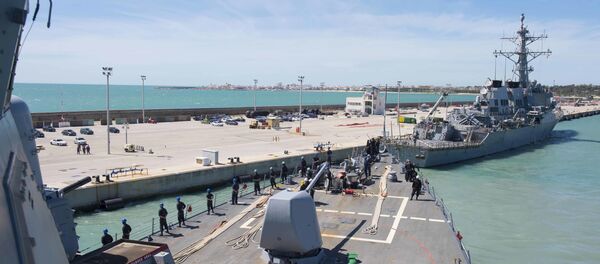ASH SHA'IRAT (Syria) (Sputnik) — The consequences of the US missile strike on the Syrian Ash Sha’irat airfield spread far beyond the military facility to the surrounding settlements, killing and injuring civilians who were calmly sleeping at their homes.
A Sputnik correspondent visited a rural hospital in Ash Sha’irat and met with the locals, who showed him the damage caused by US missile strike.
On Thursday night, the United States launched 59 Tomahawk cruise missiles at the military airfield in Ash Sha’irat. The strike destroyed eight hangars and all military equipment within, but spared several fighter jets and left the runway mostly intact. US President Donald Trump said that the attack was a response to the alleged chemical weapon use in Syria's Idlib province on Tuesday, which resulted in death of over 80 people, an incident which Washington blames on the Syrian government.
HORROR NIGHT
"That night was scary as hell, it seemed the house was shaking and I was afraid that the ceiling would fall down on me," a 14-year old boy said.
Director of the local school Khodr added that the same occurred in other villages.
"Yes, everyone was scared and the same situation was in the neighboring villages. They might strike again. But we have been living in war for six years and Americans will not make us leave our land. And if Trump wants to help the Syrian people, he should better leave Syria alone and take his terrorists back," Khodr said.
US STRIKES' ECHO
"A school was damaged in our village, the rural hospital received first victims, many houses were damaged, residents are scared as another strike may happen," the village's elder Mohammad Rostom said.
"Look, a missile dropped straight near the school entrance. All the windows are shattered. Window frames popped out at my house, injuring my daughter. Thank God, the scratches are not deep, there was more fear. Our neighbor got ears bleeding, she was taken by ambulance to Homs," the director says, while showing to the journalists damaged school classes.
He added that the only good thing was that the strikes took place in the night time, when no pupils were at the school.
On the way out of the school the Sputnik correspondent met local children, who suggested showing him other places damaged by the strikes.
Numerous houses and gardens contained signs of the US attack, with multiple metal fragments and shell craters laying everywhere, windows shattered.
"Even this morning there were an unexploded rocket broken in half. The military came and took it away," an old man said, pointing at the trench near one of the houses.
HOSPITAL
The rural hospital turned out to be rather small, the staff explained that it was private but it had all necessary medicament needed for the assistance.
"There were enough medicament and hands. The delivery of the wounded started almost immediately after the attack on the base. A total of 22 people, and seven people from our village who died. The villagers came to donate blood, which was highly needed," one of the hospital staff said.
A third of the admitted patients were shocked and very scared, and suffered from choking, pulled muscles, a light concussion and other symptoms.
"We were especially worried for those who had lacerations, but they were delivered in time to the city hospital. The bodies of those killed were immediately taken to Homs," the paramedic said.
AIRFIELD
The Sputnik correspondent headed to the partially destroyed airfield, the main target of the US strikes.
Several soldiers were cleaning the territory in front of the hangar "H" while the technical staff was inspecting an aircraft.
"It's all right. Take the aircraft on the lane and take off," a senior officer said via radio.
A SU-22 aircraft started moving and after receiving a permission it took off. The officers started applauding, while the pilot greeted them flying over at low altitude before disappeared over the horizon.
The general reported to the headquarters that the airbase was ready to perform the tasks and in less than an hour another aircraft took off.





